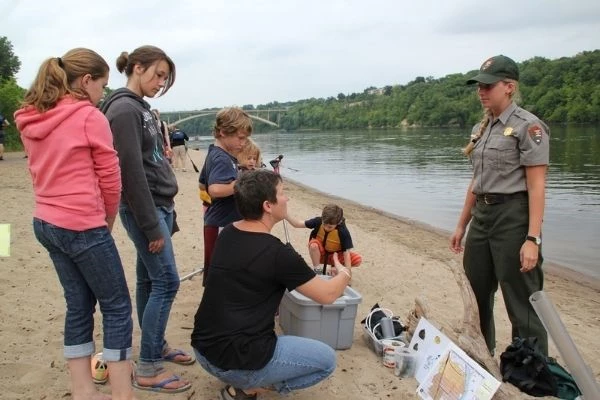Part of a series of articles titled The Power of Water.
Article
The Power of Water: Supporting Life

NPS Photo / Ivan Carabajal, Geoscientist-In-Park Intern
Supporting Life
By Raisa Barrera
Water has the power to support a plethora of living organisms. From plants, animals, fungi, algae, large, small, and everything in between, water supports life in a wide range of ways! What kind of life does the Potomac River support? How is the health of the Potomac River affected? In this NPS article you'll answer the following questions:
- What types of animals does the Potomac River support?
- What types of plants can you find along the Potomac River?
- How does human activity and industry impact water quality?
What kind of life does the Potomac River support?
The Potomac River and C&O Canal support a wide diversity of animals and plants. Click the images below to explore the different animal and plant species in your National Historical Park. Each link includes a species report with the animal's common and scientific name.
Extension: Copy and paste the name of 1 animal species per category into a search engine, view pictures, and learn more about the animals that live along the Potomac River and C&O Canal.
Animals
-
 Hoary BatMammals
Hoary BatMammalsExplore mammals species throughout the park. Photo—NPS / Isle Royale National Park
-
 Ruby-throated HummingbirdBirds
Ruby-throated HummingbirdBirdsExplore bird species throughout the park. Photo—NPS / Louise McLaughlin
-
 Midland Painted TurtleReptiles
Midland Painted TurtleReptilesExplore reptile species throughout the park. Photo—NPS / Jim Schmidt
-
 Spring PeeperAmphibians
Spring PeeperAmphibiansExplore amphibian species throughout the park. Photo—NPS / Sleeping Bear Dunes National Lakeshore
-
 Redbreast SunfishFish
Redbreast SunfishFishExplore fish species throughout the park. Photo—NPS / Great Smoky Mountains National Park
-
 Hollow-spotted Angle MothInsects
Hollow-spotted Angle MothInsectsExplore insect species throughout the park. Photo courtesy of Andy Reago and Chrissy McClarren.
Plants
-
 False SunflowerVascular Plants
False SunflowerVascular PlantsExplore vascular plant species throughout the park. Photo—NPS / Mount Rushmore National Memorial
-
 Bryoandersonia MossNon-vascular Plants
Bryoandersonia MossNon-vascular PlantsExplore non-vascular plant species throughout the park. Photo—US Forest Service / Mark Pistrang
Impacts on Water Quality
Natural Impacts
Even though poor water quality is almost always due to human activity, there are certain natural processes that can negatively impact water quality. Natural events like torrential rainfall and hurricanes can lead to excessive land loss or erosion and even landslides. Water quality may also vary in areas where water levels change throughout the year. For example, intermittent rivers and streams cease to flow every year or even twice every five years. As the water returns, many facts can impact the quality of the water bodies, like pollution, algae, oxygen levels, nitrate levels, among others.
Human and Industry Impacts
There are numerous ways that human activity and industry impacts water quality. Disturbance of forests, soils, and wetlands that once served as buffers and filters are a major way that water quality can be negatively impacted. This can include actions such as cutting too many trees or pollution of wetlands. In some instances, agriculture and farming can also impact water quality with nutrient pollution caused by fertilizers. Other actions such as trash and litter along roadsides can cause pollution to waterways as well. There are a number of ways that we can help prevent or decrease the amount of human impacts to our local waterways.

NPS Photo / Kristina Callahan
How can I help protect local waters?
There are lots of ways to help do your part to protect the Potomac River and the park! One of the best things you can do is to first get educated. Learn as much as you can about your watershed (an area or ridge of land that separates waters flowing to different rivers, basins, or seas) and then do your part. Check out the links below to find FUN resources to help you get educated and then do your part!

NPS Photo / Mississippi National River and Recreation Area
- Integrated Resource Management Applications (IRMA) Portal. https://irma.nps.gov/Portal/
- World Health Organization. (1996). Water Quality Monitoring - A Practical Guide to the Design and Implementation of Freshwater Quality Studies and Monitoring Programmes. UNEP/WHO.
Last updated: July 30, 2021
